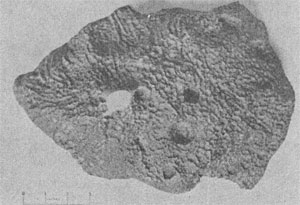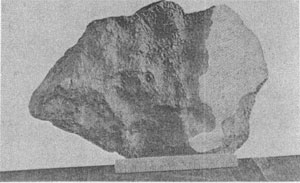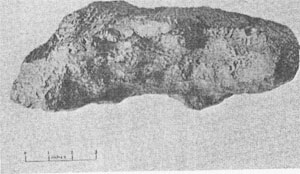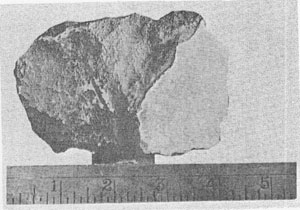| Home | AmMin | GMR | RiMG | Collectors Corner | Directory | Short Courses | |
|
|
|||||||

|
|
Volume 17, pages 357-359, 1932 TWO NEW IRON METEORITES FROM CHILE AND TEXAS CHARLES PALACHE AND F. A. GONYER THE BAQUEDANO, CHILE, METEORITE In 1930, the Harvard Mineralogical Museum obtained a new meteorite from Chile concerning which the following information was supplied by the vendor, Senor Custodio Rojas Arancibia of Antofagasta. "The meteorite weighs 22 kilograms, is 31 cm. long, 21 cm. wide, and 10 cm. in thickness. It was found near the station Baquedano, situated in the kilometer 96 of the railroad from Antogafasta to Bolivia" (Translation). The specimen was secured through letters exchanged in the course of a long correspondence between the late Dr. George P. Merrill of the National Museum and the owner of the meteorite assisted by Messrs. Thomas S. Horn and Sydney A. Browne, American Consul and Vice-Consul, respectively, at Antofagasta. The National Museum transferred it to the Harvard Collection in the course of exchange. The station Baquedano appears in the Times Atlas map of Chile as a railroad junction point in Lat. 23°13' South, Long. 69°43' West. It lies in the northern part of the Atacama Desert. The mass of iron is disc shaped; the upper face, Plate I fig. 1 is an irregular cone with minutely pitted surface; the lower surface, Plate I fig. 2, is nearly flat, with broad and shallow cavities and very little pitting. It is quite clear that the difference in detail of the two surfaces, shown in the side view, fig. 3, is due to the effect of sand blast action, the lower one, where it lay on the ground, having been protected from the wind which has developed on the exposed side the triangular pattern of the iron. The iron had suffered considerable mutilation when received. The two largest holes near the center (fig. 1) are drill holes, the other holes near the edge more probably natural features, due to solution of pyrrhotite nodules. The tip of the cone was sawed off and a chisel cut made near the left hand edge. Plate II Fig. 3 also shows in the center rough chisel and hammer scars. Fig. 2 shows a cut and etched surface, revealing the octahedral pattern of the iron. The etched surface shows bands of kamacite ranging in width from 1½ to 2½ mm. The iron is therefore to be classed as a coarse octahedrite. The kamacite lamellae are fairly straight and some extend, with interruptions, for as much as 10 cm. They are irregularly spaced. The taenite borders of kamacite plates are extremely thin. There is comparatively little plessite which is partly granular, partly finely lamellar. Pyrrhotite is very sparingly present as thin plates and in one case as a circular nodule, shown in fig. 1. Schreibersite is rather abundant in irregular plates disposed in elongated areas which show but poorly in the photograph. This meteorite therefore shows no unusual features either in physical structure or in composition as discussed on a later page. The present weight of the main mass of the Baquedano Iron is 20.15 kilograms. A small section of 880 grams is in the National Museum. PLATE I
THE DEPORT, TEXAS, METEORITE In March 1932, E. H. Sellards, Director of the Bureau of Economic Geology at the University of Texas, sent to the writer a small mass of iron which was reported to have been found by Mr. James Rhodes, one mile east of Deport, Red River County in northeastern Texas. The situation of this place is approximately in Lat. 33°30' N. Long. 95°18' West. More of the meteorite is said to be in Mr. Rhodes' possession but how much was found is not known. The specimen weighed when received 1300 grams. As shown in Plate II fig. 4 it is an irregular lump of iron with shallow pittings. The end was sawed off and polished as shown in the photograph and etching revealed a well marked octahedral pattern. The width of the kamacite lamellae classify this iron also as a coarse octahedrite. The kamacite plates are closely spaced with a minute amount of taenite separating the lamellae. The amount of plessite is also very small so that the iron is composed almost wholly of kamacite. Schreibersite is fairly abundant, partly in irregular, nodular areas, more generally in rods which show in portions of the section as minute circular sections less than one mm. in diameter and therefore far too small to be visible in the photograph. These dots reflect the brilliant white lustre of schreibersite when the section is held in the proper position. Although no pyrrhotite is shown in the section photographed, there are several nodules in other sections, the largest one cm. in diameter. This nodule is bordered by schreibersite and at one point by a small mass of graphite. PLATE II
The two meteorites above described were analyzed by F. A. Gonyer with the results shown in the following table. ANALYSES OF TWO METEORITE IRONS BY F. A. GONYER
1. Baquedano Meteorite, Chile
The analyses of these irons show normal content in nickel and no unusual features. The low sulphur in No. 1 and its absence in No. 2 simply reflect the chance of sampling for pyrrhotite is present in both. The same may be said of phosphorus which does not show in either analysis in an amount comparable with the visible schreibersite in the sections. Since the above was written two small masses of the Deport meteorite have been received at the Harvard Museum weighing respectively about six and two pounds. They add no new facts to the description of the meteorite. |



